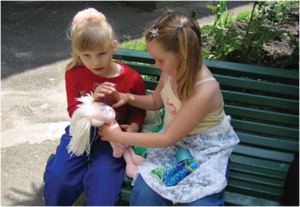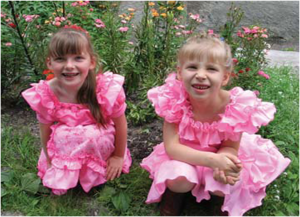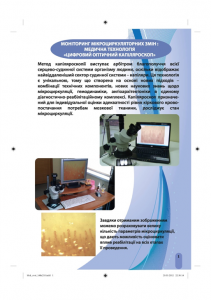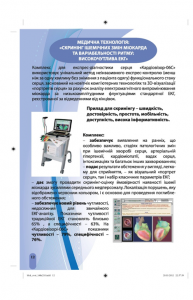Neurorehabilitation of psychoneurological patients
Rehabilitation is the most actual and complicated problem in current medicine, health protection and social aid.
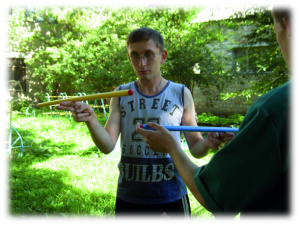 It is explained first of all by great amount of diseases with very heavy consequences, that result in disability.
It is explained first of all by great amount of diseases with very heavy consequences, that result in disability.
Today Ukraine has an active development of the rehabilitation direction.
Therefore, medical establishments create rehabilitation or restorative medicine departments and rehabilitation centers.
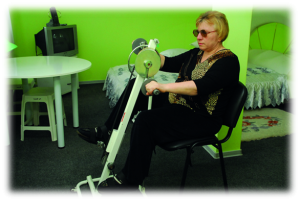
Clinical picture of a disease in psychoneurology depends not only on the somatic state, but also on the social factor. According to a definition by Ministry of Health, rehabilitation of disabled patients is a process, whose aim is to make a person to achieve his optimal physical, emotional, intellectual, psychological and social functional levels.
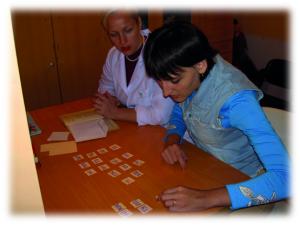
Awareness of the incapability, disorder in speech communication, disability to move himself, social and household incapability, incapability to work has considerable influence on the psyche of a patient which begins to estimate his actual catastrophic position.
All these cause social deprivation of the patient, change of his position in the society and the family.

Depression, serious neurotic states, suicidal thoughts and attempts, and other mental disorders determine important targets and tasks in treatment and rehabilitation process, it increases the role of a psychiatrist and psychotherapist as not only somatic but also mental state of the patient influence on the rehabilitation and treatment efficiency.
Thus the neurorehabilitation must be considered within the neuropsychology.
Neurorehabilitation of patients with focal brain injury, which are considered the severe category in medicine, is the most complicated direction in rehabilitation.
Lack of an integrated approach to neurorehabilitation is a cause of its poor efficiency.
 Effective neurorehabilitation provided:
Effective neurorehabilitation provided:
– maximally early beginning of the rehabilitation process;
– continuous rehabilitation to full recovery;
– its intensity;
– its optimal duration;
– integrated medical-pshychologic-pedagogical rehabilitation;
– differential and syndrome-neuropsychologic diagnostics of the higher mental functions;
adequate differentiated application of the program of the restorative training, which corresponds to a certain – form or a disease stage;
– systemic control over somatic, neurologic, mental and psychological patient’s state, functions of the brain structures and higher mental functions;
– prognosis of adequate application of any forms of neurorehabilitation;
– solving social-psychological, social-everyday and social-economical problems;
– involving family members to rehabilitation process at all disease stages;
– solving problems of moral support and motivation of the patient to recovery.
INDIVIDUAL COMPLEX REHABILITATION OF PATIENT
Patent of State Patent of Ukraine № 72725 as of 31.12.2003 “A method of neurorehabilitation of patients with an apallic syndrome”
Stages of rehabilitation
The first stage – diagnostics to find basic pathology, which needs to be treated.
The second stage – complex diagnostics of the whole organism for the detection of the corresponding illnesses.
The third stage – analysis of current pathological disorders in functioning of the organism and readiness of its systems to sanogenic alteration and rehabilitation.
The fourth stage – formation of the program for restoring treatment and rehabilitation. The primary role of adequate blood supply for the head and spinal cord must be in the basis of any rehabilitation programs in restorative psychoneurology.
The fifth stage – determination of weak links and monitoring changes in the patient’s organism for avoidance of critical states.
The sixth stage – final diagnostics of the organism in the moment of completion of restoration treatment course with ascertaining changes in all organs and systems in order to form the program for the next course of restorative treatment and rehabilitation.
The guarantee of the successful rehabilitation must be the resume of the last rehabilitation course of a certain patient.
Therapeutic management of patients in neuroresuscitation we must consider at least three aspects:
• instrumental monitoring of vitally important organs,
• dynamic analysis of sanogenic or pathological reconstructions in the organism in the critical state,
• well-organized work of the team of resuscitators and rehabilitologists.
Our Center has been working in Ukrainian medical market for more than 17 years.
And it develops innovative medical technologies, which are approved on our clinical base, in particular in the field of vascular diagnostics.
Its viability is proved by positive clinical results of the integrated neurorehabilitation of our patients and disproof of some conservative opinions regarding incurability of some illnesses.
Constant work of rehabilitating team with a patient and the patient’s tireless struggle against the disease is an indispensable condition of success in a struggle with the disease. The disease quits the organism only when it feels uncomfortable in the human mind and body.
Our society has a stereotype that the state must be a financial sponsor for support ill and disabled without any attempt to make them come back for social active life. On the other hand, a patient, who receives any state aid, gradually gets used to this and has less motivation to active way of life.
But only with stimulation to work and orientation to social importance of every person, our society can hope for changing priorities in invalids: the necessity of rational employment must dominate over necessity to receive a disability pension.
A problem of disabled children is very urgent.
The status automatically excludes one parent from the cadre resource because of the constant necessity to look after the child. Then the parents directs their activity to get a pension for the child. Next step – how to survive. A matter of treatment and intensive rehabilitation recedes into the background. At best such patients have necessary treatment and rehabilitation one time a quarter.
Thus, a state program for training rehabilitating teams is urgently necessary for professional work with such children unlike some mothers’ attempts to perform rehabilitation tasks.
Besides, it is necessary to combine efforts of social services with other professionally orientated services in order to treat a patient efficiently and after some time to demonstrate achieved results.
Our experience demonstrates that in order to achieve stable results the patient must have everyday complete complex of rehabilitating tasks both in moving and speech, logical, psychological and other spheres; for formation of the balanced individual but not to do only some selective stimulations of one function on a background of mosaic formation of various functions in the organism.
One, who makes a proper diagnose, can treat well
Serious conditions of patients require thorough examination of cardiovascular system, the brain and spinal cord, internal organs, locomotor apparatus for specification of an adequate treatment tactics, which are presented in numerous methods, created in the Center and based on the constant monitoring the organism’s condition and restoration of functions that were lost or not developed.
Due to well organised process of individually-oriented rehabilitation, comparing to the current standard approach, it is possible to attain the increase of efficient treatment in two-five times for the same time and retaining of stable positive results from one to three years.
SCIENTIFIC APPROACHES AND ALGORITHMS OF REHABILITATION
Main profile of medical aid
• detailed complex clinical-instrumental examination of patients from psychoneurological and vascular profile;
• individual selection of adequate medicines;
• holding necessary psychocorrection and rehabilitation.
Medical rehabilitation
It’s a medical therapy, restorative and cosmetic surgery, physiotherapy, therapeutic physical exercises, kinesitherapy, psychotherapy, diet-therapy, complementary methods (acupuncture, manual therapy, phytotherapy, homeopathy, efferent therapy)
Early medical rehabilitation
It’s a complex of restorative measures that starts from the first day of the pathological process development. It is must be an individual approach.
The early the rehabilitation starts, the better final result be .
Social rehabilitation
Some measures directed into creation and providing conditions for social integration of an invalid into the society, renewal of his social status and ability to individual social and family activity, orientation in the environment, social-everyday adaptation, social needs in technical and other means of rehabilitation.
Professional or labour rehabilitation
It’s a system of measures directed into preparing an individual to professional activity, renewing of acquiring professional skills owing to readaptation, training or retraining with further job placement and required social accompaniment taking into account special habitude, physical, mental abilities, providing labour adaptation in practice in particular creating new special working places.
Physical rehabilitation
With therapeutic and preventive purpose it is an application of physical exercises and natural factors in the complex process of health restoration to work ability state.
Family psychotherapy
It is a multi-aspect work for assisting relatives to realise patient’s problems and conflicts’ reasons because of his illness. The work must be continuous and involve relatives into the rehabilitation process, social-everyday and work adaptation of the patient, speech restoration and other higher mental functions. Explaining the relatives’ importance in the rehabilitation process and adaptation of the patient to new life conditions is very serious moment in the work.
MULTIDISCIPLINARY APPROACH TO TREATMENT:
HARMONY OF MIND AND BODY
Psychoneurology
Today physicians quite often face with psychosomatic diseases, which imply intention to run away from reality. The patient shrinks into the disease’s shell, because he can’t solve his problem. Realization of the necessity in detecting psychological purposes and blocks for further existence of the individual is the most important property of psychoneurology. This enables to subdue loss of interest to one’s life or domination of fears over intention to act after long-term and disruptive stresses. That’s why the problem of combining knowledge and experience both of a psychologist, psychiatrist, neurologist, and sanologist takes the first place in psychoneurology
Alternative medicine
Landscape-therapy means getting positive emotions by diving into world of nature. It is one of the easiest methods for restoration of forces. But we should not only be in a harmony with the nature but also avoid conflicts between the consciousness and the body. There are a lot of illnesses that starts with this conflict as a protest of inner nature against some actions of the individual. Thus the process must take into account not only body but also the soul.
Psychotherapy
A lot of various physical and chemical factors influence human organs of sense. Their application in treatment is another step into nature. Sense of smell, hear, vision can be used for relaxation or organism’s activation.
It is well-known aromotherapy – inhalation of aromatic oil not simply stimulates positive emotions, but have a medical influence.
And musical works can change the frequency of heartbeats and harmonize a rhythm of brain functioning.
Music therapy enables not only to overcome stress and neuroses but also somatic diseases.
Owing to art-therapy human can change his attitude to problems reproducing everything that bothers with art means. Creative thinking, fantasy is developing during painting or other art activity. Patients can show their inner sense, get into contact and gradually broadens their world view changing their attitude to own emotional experience and blocks.
Illnesses of locomotor system
Our skeleton is a core support that holds all organs and tissues. Naturally that overweight, sudden physical overloads, serious overcooling etc. can cause illnesses of locomotor apparatus such as osteochondrosis, arthritis, arthrosis etc. Today there is an intensive investigation of musculoskeletal system. Ultrasound investigation of locomotor system enables to observe a full picture of the condition of joints, articular cavity and the spine, to make accurate diagnosis and to determine a cause of the disease. Owing to this one can select a treatment that corrects metabolism and blood supply for bone tissues with further rehabilitation course with massage and kinesitherapy.
Kinesitherapy (gr. kinema – motion) means a treatment with motions
This newest non-medicinal method of therapy is a natural way of influencing pathological processes. Unlike medical physical culture it is based not only on knowledge of anatomy and biomechanics but also on pathophysiology of the cardiovascular, nervous and other systems in the organism. Motional stimuli is necessary for supporting physiological functioning of the nervous cells. Kinesitherapy actively uses an unique potential of nervous tissues such as neuronal plasticity, which enables to create “emergency” collateral tracts in case of defects in it. Thus, we achieve rehabilitation of the central nervous system in patients that suffered from very serious conditions. The patient can restore his abilities to move in every-day, social and professional activity, which he used to have before the illness
We live for hope and gives hope to everyone who dreams of recovery
Tanya B., born in 1998
Diagnosis: Down’s disease. Arrest of psycho-speech and stato-kinetic development.
Beginning of treatment: August 2004
Had 10 scheduled courses of intensive developing treatment (duration 15 days each) till October 2007
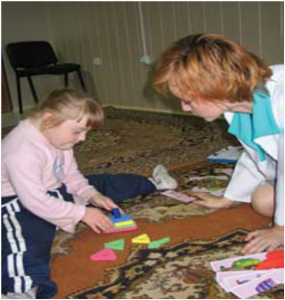 Dynamics
Dynamics- a) neurological:
Before treatment – absence of speech comprehension and reproduction, unable to be organized, orientation reflexes without instinct of self-preservation, active negativism to surrounding;
After treatment – comprehends the lessons’ structure, stable attention, performs motional instructions of average difficulty, during communication with coevals takes the initiative;
 b) hemodynamical:
b) hemodynamical:
Before treatment–intracranial hypertension in the anterior cranial fossa, venous hypertonia (more on the left side), expressed pathological shunting into the cavernous sinus;
After treatment – signs of slight intracranial hypertension in the anterior cranial fossa, moderate venous hypertonia, pathological shunting decreases up to a thread-like; - c) psychological:
Before treatment – general development of the psychological sphere corresponds to two-years-old age;
After treatment – the girl can study skills of self-service. Development of the speech- increasing of active and passive vocabulary, makes simple sentences, keeps a dialog, can apply to adults herself.
Development of the speech- increasing of active and passive vocabulary, makes simple sentences, keeps a dialog, can apply to adults herself.
Acquires skills of reading, counting. Cognitive processes become more voluntary, thinking is developing. She can paint a sun, cloud, rain, flower herself.
d) logopedic:
Before treatment – second prespeech level of development;
After treatment – second speech level (speech with simple sentences) 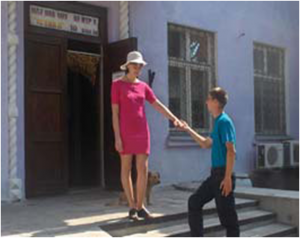
- Viktor S., born in 1983
Diagnosis: moderate oligophrenia. Mental retardation on the background of bilateral piramidal deficiency.
Beginning of treatment: December 2005
Had 3 scheduled courses of intensive developing treatment (duration 21 days each) till November 2006 - Dynamics
а) neurological:
Before treatment – reduced contact due to lock-in and simplification of questions’ comprehension. Makes mistakes while performing difficult tasks. Reduced level of emotions. No disorders in motor sphere. Coordinator and sensitive spheres without disorders; 
- After treatment –age social skills were formed, leveled psychoemotional state, initiative appeared for finding himself as a man and he asserts his position using wide logical conclusions, quick changing of attention from one to another activity, increasing of physical and mental activity;
b) hemodynamic:
Before treatment – spasm of both carotid arteries, intracranial hypertension in the anterior cranial fossa, pathological arteriovenous shunting on the right into the cavernous sinus, functional insufficiency of the aortic valve, decreasing of the pumping function of the heart;
After treatment – normalization of the pumping function of the heart left sections, better venous outflow and blood flow in middle cerebral artery, but decreasing of blood flow in anterior cerebral artery, and arteriovenous shunting on the right into the cavernous sinus remains; 
- c) psychological:
Before treatment – absence of skills to self-communicate, fears of people. Disturbed selectiveness of visual perception, concentration and distribution of attention. Connected thinking, answers slowly. Emotional sphere- decreased emotiveness, simplified emotions. Decreased reflexes. Tendency to autisation, unable to keep warm relations. Low self-estimation and high level of criticism to himself.
After treatment – the boy mastered a job of masseur, is working by the specialty. Significantly increased indexes of functioning of cognitive processes. Interested in fiction. Retells what he read interestingly and accessibly. More confident in communication, can perform creative work. Adequate self-estimation.
d) logopedic:
Before treatment – speech unclear, poor in verbs, impulsive, he refuses to read and write;
After treatment – accurate articulation, stable strong voice, short but accessible sentences, take part in theatre group – acts as a king. 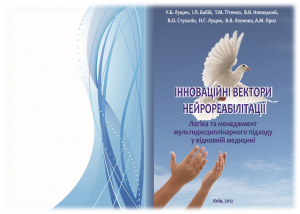
- UB Lushchyk, IP Babii, TM Titenko, VV Novytskyy, VO Stukalin, NG Lushchyk, VV Leonova, AM Priz , 2012
- Innovative vectors of neurorehabilitation
- Logic and management of the multidisciplinary approach in rehabilitation medicine
- The book is dedicated to cover the important role of reliable innovative approaches in restorative treatment. It contains materials that can be useful managers of the sphere of health protection and public health, specialists in restorative medicine and others concerned.






